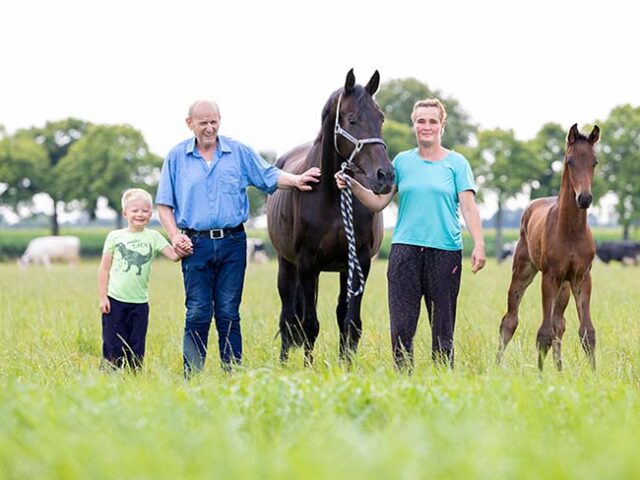By Sabine Timman
Photography: Sabine Timman
Hermès is currently the star of the Gijsbers family’s breeding. The sympathetic stallion with his rider Dinja van Liere continues scoring, and made dreams come true at the World Equestrian Games in August with team and individual bronze medals. This success story was not so obvious at the start, but Joop van Uytert believed in the stallion bred by the Gijsbers family.
Sadly, Grad Gijsbers passed away a few years ago and the breeding has now been completely taken over by his son Ad and his partner Elcke Govers, whom we are now visiting.
Q How did your breeding started?
A year before my father got married in 1962, he bought a horse, the ‘Gelderse’ mare Wiesje. Wiesje came out of the stallion Majesteit out of the Emir mare Jannienke. That’s where it all started and almost all our broodmares descend from her. Earlier, my father had bought a horse for working in the fields. When tractors came along she was no longer needed for this purpose, so she became a broodmare. One of her foals was the mare Lady, from Doruto.
At that time we were still using natural breeding and this stallion was close by. Many breeders thought we were crazy because Doruto was a very chic horse for that time and the people here preferred something sturdier, like the work horses. But it turned out well. Lady gave birth to 16 foals here.
The two mares Lady II and Janny both came out of Lady and descended from the stallion Chronos. Those two can be found in almost all broodmares who are still with us today. One of these mares measured just 161 cms, while the other was a little bigger and longer lined. So, they were called the small and the big Chronos. Both mares gave us many foals. Lady II, for example, is known as the dam of Ulinda (Jazz) who produced the Grand Prix horse Aswin (Sandreo) and Small Tour horse Brown Boy (Sandreo). Lady II also produced the Small Tour horses Digo (Johnson) and Webster (Rhodium). From Janny came the mare Ukkie (Jazz) who gave birth to Bukkie (Flemmingh), the mother of Hermès. But Janny also produced the Grand Prix horse Zeb (Jazz) and Small Tour horse T.Movistar (Jazz).
Q What has been an important point of attention in your breeding?
The Chronos offspring could never do well at the studbook inspections. At that time, that result was important; so many breeders wanted to get rid of their Chronos mares, but we didn’t. We saw something in them and continued to believe in ourselves. In our breeding we needed to focus on size as the first mare was so small, so we had to keep an eye on that in order to get a kickback sooner than breeding a very large horse. Also, each horse’s back is a point of attention and, on paper, their character.
We have bred a lot by Jazz, and he gave us sensible horses that are all very honest. But you have to take notice of this so you are not going to breed extra Jazz or sensitive blood into it. That character is just really important right now. Some 70% of the people who ride horses are riding for pleasure after their work and do not want to have to lunge for 45 minutes before they can get on the horse. For the top there must of course always be something there, but it must remain trainable.
We would like to breed for top sport, but if a horse is not good enough for that, then it must be a nice horse for an amateur. You should not delude yourself that they will all end up with a top rider and you should definitely take notice of that. You can sometimes take a little more risk with regard to a stallion’s character with those mares that produce top horses time after time, but with the more normal mares that just give fine, usable horses you really have to choose a very nice stallion that can be worked on... To read the complete article you need to be a subscriber
CLICK HERE TO SUBSCRIBE TO BREEDING NEWS
SUBSCRIBERS CAN READ THE COMPLETE ARTICLE BY LOGGING IN AND RETURNING TO THIS PAGE





